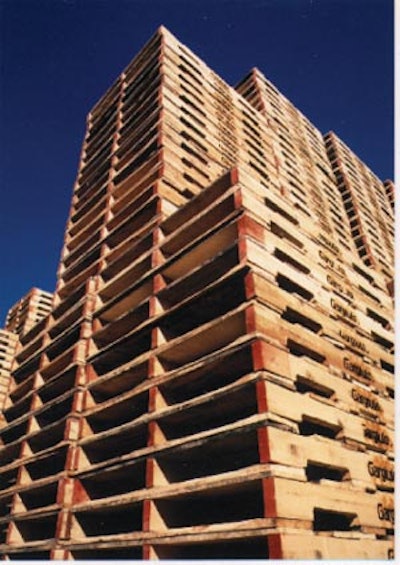
Despite efforts to find alternatives, wood pallets are still everywhere, comprising 93 percent of the entire world pallet market. They are just as prone to damage as ever, and when they've reached a point when they can no longer be repaired, disposal options are limited. In fact, many landfills are no longer willing to accept them at all.
In response, a growing number of pallet manufacturers are now turning to recycling to provide an environmental solution to the world's wood pallet problem. And for those who rely on wood pallets for shipping and storing their products, this new industry offshoot is providing an added revenue stream. Wood pallet recyclers pay between $1 and $3 for each pallet turned in for recycling.
"When we buy pallets back, we'll pay anywhere from 75 cents to about $3 each, depending on how good the condition they're in and how much business the company does with us," says Pat Sherry, general manager of Nepa Pallet and Container Co., Snohomish, WA, a company which puts out about 750,000 new pallets and 500,000 repaired or reconditioned pallets each year.
"There are literally thousands of factors that go into how much we buy back pallets for," adds Robert Wenner, president of Pallet Service Corp., Maple Grove, MN, a company which recycles roughly 400,000 to 500,000 pallets a year. "It really depends on the retailer, for example, and what kind of pallets he gets into his distribution center in the first place."
If you're still throwing used pallets away, not only are you missing out on some revenue potential, but you're actually wasting money. "It's way too expensive to put pallets into the waste stream," Wenner explains. "You pay your garbage haulers based on the size of your dumpsters, and you would need bigger dumpsters because [pallets] take up a lot of space."
And, it costs nothing to turn over pallets for recycling. Most recyclers will pick up used pallets at your store, plant or distribution center free of charge, though they usually require minimums of 100 pallets before making the trip. "We'll even have a trailer spotted at a customer's distribution center if we know there's a shipment coming in," Wenner says.
Pallet Service Corp. and Nepa are just two U.S. companies involved in pallet recycling. Of the 2,300 wood pallet manufacturers around the country, about two-thirds do some pallet recovery and recycling, and the industry is growing, says Bruce Scholnick, president of the National Wood Pallet and Container Association (NWPCA), based in Alexandria, VA.
"The pallet recycling industry is larger today than it's ever been in the past, mainly because the finished goods are far less expensive than new, and because lumber prices have gone way up these days," says Scholnick.
Recycling Extends Use
SMI Co., Cresco, IA, processes more than 3,000 pallets a week, putting them back into the market to be used again and again. "We utilize the same stringent quality control systems on our recycled pallets as we do on our new pallets. Our recycled pallets offer the same performance as our new pallets, but at a greatly reduced price," says a company spokesperson.
These pallet recyclers take in used wood pallets, repair any damage and resell them, usually for between 20 percent to 50 percent less than new ones. Pricing is generally based on the condition, or grade, of the pallet.
"Everyone is looking to get costs down, and you can pay $9 or $10 for a new pallet or $6 for an almost-new one," says Nepa's Sherry. His company sells brand new 48-inch-by-40-inch GMA pallets for between $8.50 and $10 each. Recycled pallets in great condition sell for between $5.50 and $6; lower-grade recycled pallets sell for $3.50 to $5.
Scott Shaw, president of Premier Pallets Inc., Tampa, FL, maintains the following grade scale for recycled pallets:
- Sam's A-Grade: the highest grade recycled pallets used in wholesale club operations. They have no plated stringer repairs, painted stringers or softwood lumber. All have 6-inch leading edge boards.
- Premium A-Grade: Similar to Sam's A-Grade, but they may include plated stringer repairs and painted stringers.
- Standard A-Grade: Quality pallets that may have been repaired a few times. They may have 4-inch or 6-inch leading edge boards.
- One Stringer B-Grade: They contain only one double or sister stringer repair.
- B-Grade: May contain one or more double or sister stringer repairs.
"Our recycled grocery pallets (48-inch-by-40-inch, four-way pallets) are repaired, graded and sold based on each pallet's condition," he says.
Recycling is also extending the life expectancy of wood pallets. Most wood pallets average 1.7 trips before being damaged. With recycling, a typical wood pallet can go back and forth for about three or four years, Scholnick says. "Its lifecycle depends on how much the forklift driver abuses or doesn't abuse it, how it's used or misused. The stringer and lead deck board are usually the first things to go because that's where the forks hit them, but they can be easily replaced."
When wood pallets have reached the point where they cannot be repaired, the wood can be recycled to create building materials like flooring, paneling, furniture, cabinets and more. They can also be ground up for animal bedding, mulch, fuel, soil amendment, particleboard, pulp, wood packaging or charcoal. That kind of pallet recycling generates about $3.5 billion annually across the nation.
For Nepa, about 10 percent of the pallets that it receives for recycling fall into that category. Several others are not worth reconditioning because they are odd sizes and there is not much of a market for them.
"Grocery pallets are very recyclable because they are a standard size. Pallets in some other businesses are not so much, and that's where we run into problems," says Sherry. "We have to be selective in who we receive pallets from. Old pallets are a garbage problem for them, and we do not want to make it our garbage problem."
Wood from unusable pallets is also being used to make composite pallets—a combination of post-industrial wood fibers and plastic resins. These pallets, though, are "about 10-15 pounds heavier than traditional wood pallets and cost a lot more," Scholnick says.
Alternative Sources
For those companies that do not want the responsibility of handling the storage and recycling of their own used or damaged pallets, Industry insiders recommend pallet leasing services. With such services, responsibility for repairing damaged pallets and getting rid of those that cannot be repaired falls with the pooling company, not the individual pallet user.
The two leading pallet poolers in the country, Orlando, FL-based CHEP, and Houston-based IFCO Systems, both have very comprehensive recycling programs in place. CHEP, which regularly has more than 265 million pallets and containers in circulation in 42 countries, recycles its own blue pallets, reportedly eliminating more than 6 million tons of wood from the solid waste stream each year. IFCO reportedly recycles 45 million wood pallets each year.
Pallet recycling has also taken hold in other industry segments as well. Aluminum pallets, like those produced by Rhino Pallets, Detroit Lakes, MN, are 100 percent recyclable, just like any other metal. And, the returns are great.
"If a customer has an aluminum recycling program in the area, he can take it there and the returns are really good," says Doug Christians, general manager of Rhino Pallets. "We hope our pallets never get to that level, but if they do, a company can fetch whatever the current aluminum prices are now for recycling."
Aluminum recyclers are currently paying about 50-60 cents per pound, so a standard 40-inch-by-48-inch pallet that weighs 37 pounds could fetch as much anywhere from $18 to about $22 at the recycling lot.
Rhino can handle the recycling as well, "but the cost of getting the pallets back to us are probably cost prohibitive," says Christians. "It's much more cost effective for them to take them to the local recycler on their own."
And because aluminum pallets are far more durable than wood ones, it could also mean fewer trips to the recycler. "We have companies that have well over 100 turns with our pallets. They can last anywhere from five to 10 years or more, depending on how they are handled," Christians says. "They are not indestructible by any means, but they are easy to repair. All a company has to do is just give us a call and we'll send them the replacement parts and they can do the repair themselves."
Plastic pallets are also finding a niche among recyclers. Unusable plastic pallets are frequently being ground into plastic flake to make new pallets.
"We offer a unique buy-back program that also supports our efforts to be environmentally aware," says Ralph Harris, president of Decade Products, Grand Rapids, MI, the exclusive supplier of Greystone plastic pallets. "It allows customers to turn in used pallets for recycling and earn credit towards the purchase of a new pallet."
<><><><><><><><><><><><><><><><><>
Wood Pallets, At A Glance
- Wood pallets comprise 93 percent of the entire pallet market;
- Annual new pallet sales total $3 billion;
- Between 450 million and 500 million wood pallets are manufactured each year;
- Wood pallet manufacturing is the single largest use of hardwood lumber. Nearly 38 percent of America's hardwood lumber, or 4.5 billion board feet, are used to make wood pallets every year;
- About 270 million wood pallets are refurbished/repaired each year.
- Source: National Wood Pallet & Container Association, Alexandria, VA.













